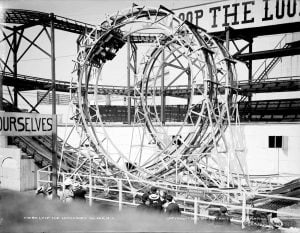Hot Springs of Gardiner’s River

Yellowstone Park: What it was like more than 100 years ago
From Wonders of the Yellowstone region in the Rocky Mountains, by James Richardson (1874)
The entire area, hemmed in by the loftiest peaks of the Rocky Mountains, is over 6000 feet above sea level; and the Yellowstone Lake, which occupies an area of 15 by 22 miles, has an elevation of 7427 feet.
The whole region is of Pliocene age, and bears unequivocal traces of its having been the scene of prolonged and energetic volcanic activity.
The hot springs and the geysers discovered by the explorers represent the latest stages of these remarkable volcanic manifestations. The geysers of Iceland become dwarfed in comparison with the hot springs and geysers of the Yellowstone and Firehole Basins.
The explorers describe with enthusiasm the geysers in the latter region, the largest of which, named the Grand Geyser, begins an eruption by filling its basin with boiling water, forming a well 20 by 26 feet in diametric measurements, and having a visible depth, when quiet, of 100 feet.
The explosion is preceded by clouds of steam rushing up to a height of 500 feet; the great unbroken body of water succeeds, ascending in one gigantic column to a height of 90 feet; while from the apex of the column there radiate five great jets which shoot up to the unparalleled height of 250 feet from the ground.
“The earth trembles under the descending deluge from this vast fountain; a thousand hissing sounds are heard in the air; rainbows encircle the summits of the jets with a halo of celestial glory.”

This is characterized as being the grandest, the most majestic, and most terrible fountain in the world. All the writers dwell with delight on the exquisite beauty and variety of the mineral and metallic sediments deposited by the hot springs and geysers.
In some cases, it was noticed how speedily vegetable substances and even insects were petrified by being immersed in water holding silex in solution. The number of hot springs of all kinds, including geysers, in the Firehole Basin alone is not less than fifteen hundred, all varying in times of action, force, deposits, and color of water.
Taken as a whole, the explorers claim for the thermal phenomena of this basin a superiority to all the other wonders of the American continent.
Not the least of the marvelous scenes of the Yellowstone are the Grand Canon, which the river traverses on its way from the lake, and the upper and lower falls over which it is precipitated.
MORE: The story of Smokey the Bear, and how only YOU could prevent forest fires
The canon is of enormous depth. The stream is visible below, dashing against the cliffs and boulders which obstruct its progress, but no sound is heard. By trigonometrical measurement the chasm at one place was found to be 1190 feet below the brink.
But several of the explorers descended to still greater depths, and, looking up through the gloom, could discern the stars soon after mid-day, so much was the sunlight prevented from entering the chasm.
The total depth at this place was estimated at 2500 or 3000 feet. Portions of this savage ravine are beautified by the siliceous deposits of ancient hot springs, which have assumed every shade of color; and we are told that “when the light falls favorably on these blended tints, the Grand Canon presents a more enchanting and bewildering variety of forms and colors than human artist ever conceived.”
The tower of Tower Falls, Yellowstone

The Castle Geyser, Upper Geyser Basin

The Great Blue Spring of the Lower Geyser Basin

Tower Falls and Sulphur Mountain

MORE: Vintage travel posters: 50 places you can see by train or plane
Yellowstone Lake in the 1870s

Lower Yellowstone range more than 100 years ago

ALSO SEE: Old Florida hotels & historic resorts: Trip back to these amazing Victorian vacation destinations


















